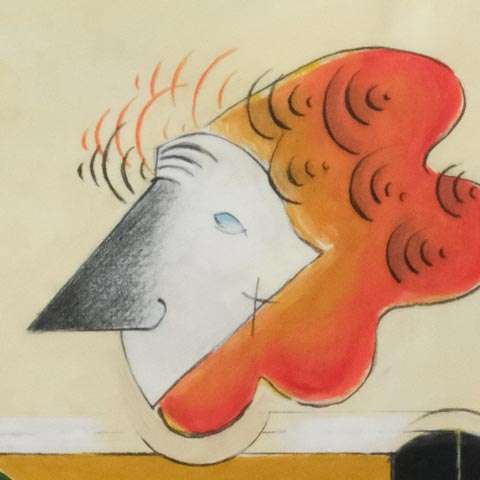
MASTERPIECES
NEMUKHIN Vladimir Nikolaevich (1925–2016) Jack of Diamonds Rooster (Bertuccio-Meyerhold). 1997. Oil on paper, collage. 99.5 × 69.5
Before us is Nemukhin's work from a cycle dedicated to the leaders of the Russian avant-garde. He has Jack Mayakovsky. Jack Marc Chagall. In this case, it is a dedication to the figure of the theatrical avant-garde, director, theater innovator, reformer and experimenter Vsevolod Meyerhold. The figure is very complex, ambiguous and colorful. It is not without reason that Meyerhold was painted by Yuri Annenkov, Boris Grigoriev, Alexander Golovin and other outstanding portrait painters of their time. Malevich made the sets for his production of Mystery-Buff based on Mayakovsky's material. And Mayakovsky personally played several roles at the premiere instead of the actors who did not appear.
Some adored him, others hated him. For different reasons. His innovation, the theater of convention, which later took shape in a system of biomechanics, was hard to accept by the public. Even before the revolution, Meyerhold almost ruined the theater of Vera Komissarzhevskaya in St. Petersburg. The performances were so grotesque and unusual that the audience stopped going to her theater. Mikhail Bulgakov did not like the ascetic scenery and shameless movements of the actors in Meyerhold's productions, he even ridiculed the director in one of his works. Well, needless to say that Stalin, too, could not stand the work of Meyerhold.
And the director took a fierce death. In 1940, he was arrested by order of Beria for working for Japanese and Lithuanian intelligence. They tortured him for a long time, drove him to the point of losing his mind, and then shot him. The wife, who protested loudly and wrote letters in defense, was also killed. Unofficially, some unidentified persons, so as not to raise a fuss. Meyerhold's ashes are buried in a common grave near the Donskoy Monastery.
Such is the difficult Jack we have this time. Very good work.
ZVEREV Anatoly Timofeevich (1931–1986) Portrait of a girl. 1981. Oil on cardboard, scratching. 69.5 × 49
What does Valery Silaev write in the examination? The presented portrait compares favorably with the custom-made mass production of Zverev in the late 1970s — early 1980s. It should be noted that this portrait was painted with good colors, and “Zverev was anxious and attentive to professional materials. Hence the good quality of this work... The result: a little stingy in color, but at the same time an exquisite portrait, which brilliantly conveys the charming image of a pretty girl”.
POSITIVE
KOKURIN Valery Grigorievich (1930–2019) Spring. 1975. Oil on cardboard. 32.5 × 56
One of the three main artists of the Vladimir school. Our subscribers remember the history of this phenomenon. 1960, republican exhibition “Soviet Russia” in Moscow. Britov, Yukin, Kokurin — bright, unusual, “unprincipled”. It seems that they are neither enemies, nor formalists, nor “underground members”. But aesthetically, it is a pronounced opposition to ideologically charged socialist realism. While everyone was writing collective farmers, tractors and socialist construction sites, the painters of Vladimir chose work with eternal values. Here is Kokurin. See for yourself: positive, nature, light. The work, by the way, is 45 years old — it was written in 1975.
FOR THE FIRST TIME AT OUR TRADES
SUDEIKIN Sergey Yurievich (1882–1946) Portrait of a girl. 1924. Lead pencil, ink, whitewash on paper mounted on cardboard. 46 × 36
This is the name! Symbolist, innovator, theater painter. Original and badass. From the Moscow School of Painting, Sculpture and Architecture, he, along with Mikhail Larionov and Artur Fonvizin, was expelled for an unauthorized exhibition of obscene content. And the authorities did the right thing.
Sergey Sudeikin, together with Kuznetsov, Utkin, Borisov-Musatov, Krymov, Saryan, are members of the famous Blue Rose association. Why was the installation exhibition and art association named “Blue Rose”? This romantic image is a symbol of an unattainable ideal and a symbol of royal blood. Let's digress. In nature, blue roses are not found. And those that are for sale are artificially colored flowers. But about 15 years ago, geneticists managed to come close to solving this problem and almost conquer nature. The new variety of roses was named “Blue Moon”. But this is upfront. In fact, its color gives off to purple. So the blue rose is still an unattainable ideal.
A recognizable feature of Sudeikin is farce plots, popularist atmosphere, harlequin-columbines, fun, debauchery and hooliganism. Difficult life, difficult relationship, difficult fate. In 1920, Sudeikin was able to escape from the Land of the Soviets. He moved to Paris, designed Russian ballets, then left for the USA. Overseas, he worked on Stravinsky's ballets, painted bespoke portraits and collaborated with Hollywood (was the artist of several films).
Here is our portrait — it's like the early American period. In good condition, without restoration. The picture has the expertise of Valery Silaev.
Sudeikin is an expensive and demanded artist. In 2012, at Sotheby's, the price of his big painting was set at a step from one million dollars. And the results of $ 200,000–300,000 were not out of the ordinary. By the way, the record for Sudeikin's graphics is just $ 275,000.
Expert Valery Silaev notes that the portrait can be of museum value. “The portrait is executed stylishly, confidently, in an excellent drawing manner and in an exquisite, decorative manner typical for this period of Sudeikin's work.”
- Log in to post comments










